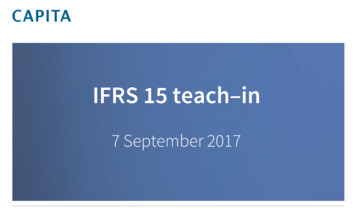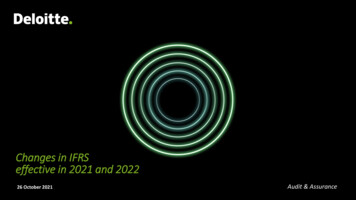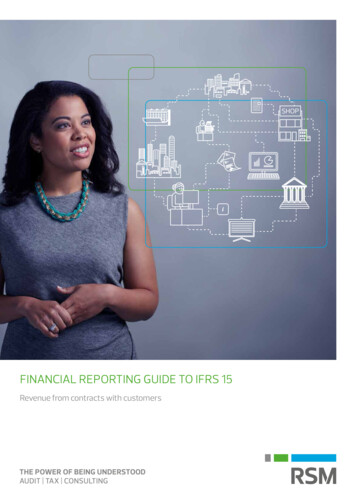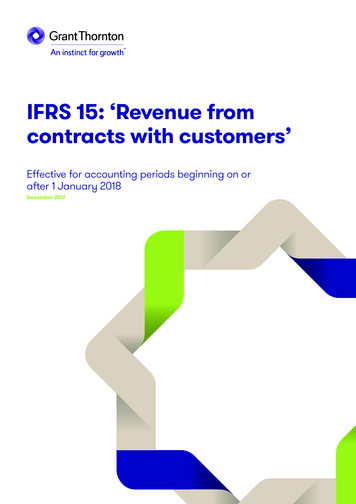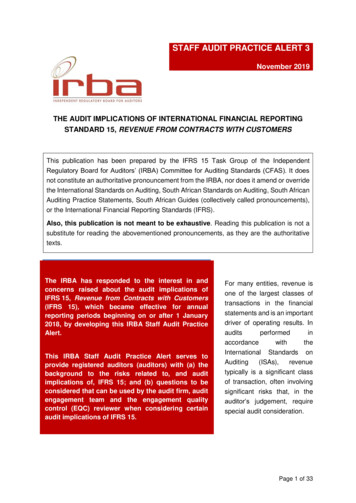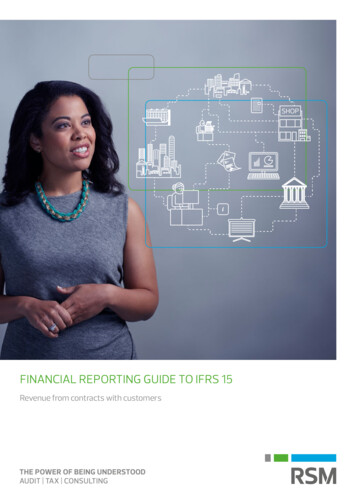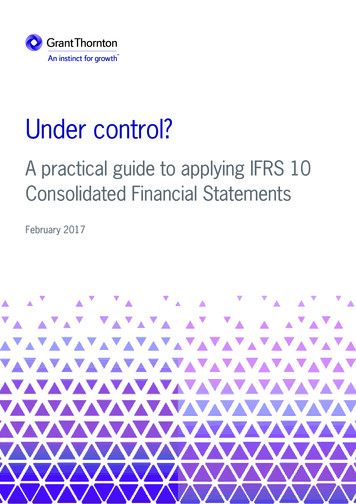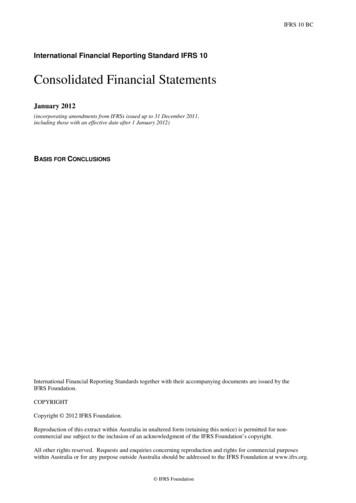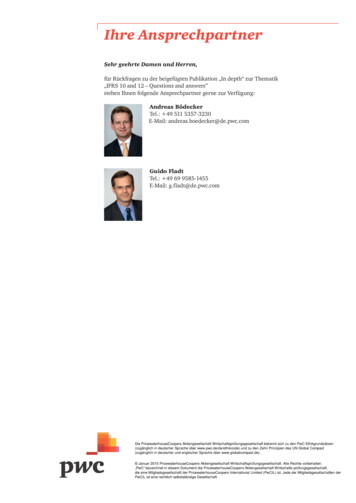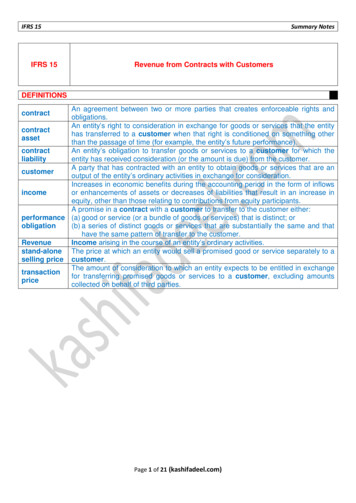
Transcription
IFRS 15IFRS 15Summary NotesRevenue from Contracts with CustomersDEFINITIONSAn agreement between two or more parties that creates enforceable rights andobligations.An entity’s right to consideration in exchange for goods or services that the entitycontracthas transferred to a customer when that right is conditioned on something otherassetthan the passage of time (for example, the entity’s future performance).contractAn entity’s obligation to transfer goods or services to a customer for which theliabilityentity has received consideration (or the amount is due) from the customer.A party that has contracted with an entity to obtain goods or services that are ancustomeroutput of the entity’s ordinary activities in exchange for consideration.Increases in economic benefits during the accounting period in the form of inflowsincomeor enhancements of assets or decreases of liabilities that result in an increase inequity, other than those relating to contributions from equity participants.A promise in a contract with a customer to transfer to the customer either:performance (a) good or service (or a bundle of goods or services) that is distinct; orobligation(b) a series of distinct goods or services that are substantially the same and thathave the same pattern of transfer to the customer.RevenueIncome arising in the course of an entity’s ordinary activities.stand-alone The price at which an entity would sell a promised good or service separately to aselling price customer.The amount of consideration to which an entity expects to be entitled in exchangetransactionfor transferring promised goods or services to a customer, excluding amountspricecollected on behalf of third parties.contractPage 1 of 21 (kashifadeel.com)
IFRS 15Summary NotesFIVE STEP RECOGNITION APPROACHThe core principle of IFRS 15 is that an entity recognises revenue to depict the transfer ofpromised goods or services to customers in an amount that reflects the consideration to which theentity expects to be entitled in exchange for those goods or services. An entity recognisesrevenue in accordance with that core principle by applying the following steps:1 Identify the contract(s) with a customerThe entity would normally treat each contract separately but in certain situation contracts maybe combined. The key factor is “price interdependence”.2 Identify the performance obligations (PO) in the contractEach PO is accounted for separately only if the promised goods or services are distinct. Agood or service is considered ‘distinct’ it is, or could be, sold separately because it has distinctfunction for customer and is separately identifiable from other promises in the contract.3 Determine the transaction price (TP)The TP is the amount of consideration in a contract to which an entity expects to be entitled inexchange for transferring promised goods or services to a customer. The TP can be a fixedamount of customer consideration, but it may sometimes include variable consideration orconsideration in a form other than cash. The TP is also adjusted for the effects of the timevalue of money if the contract includes a significant financing component and for anyconsideration payable to the customer. If the consideration is variable, an entity estimates theamount of consideration to which it will be entitled in exchange for the promised goods orservices. The estimated amount of variable consideration will be included in the TP only to theextent that it is highly probable that a significant reversal in the amount of cumulative revenuerecognised will not occur when the uncertainty associated with the variable consideration issubsequently resolved.4 Allocate the TP to the PO in the contractAn entity typically allocates the TP to each PO on the basis of the relative stand-alone sellingprices of each distinct good or service promised in the contract. If a stand-alone selling priceis not observable, an entity estimates it. Sometimes, the TP includes a discount or a variableamount of consideration that relates entirely to a part of the contract.5 Recognise revenue when (or as) the entity satisfies a POAn entity recognises revenue when (or as) it satisfies a PO by transferring a promised good orservice to a customer (which is when the customer obtains control of that good or service).The amount of revenue recognised is the amount allocated to the satisfied PO. A PO may besatisfied at a point in time (typically for promises to transfer goods to a customer) or over time(typically for promises to transfer services to a customer).Page 2 of 21 (kashifadeel.com)
IFRS 15Summary NotesSTEP 1: IDENTIFY THE CONTRACT(S) WITH A CUSTOMERCriteriaReassessmentof criteriaConsiderationreceived inadvanceCombination ofcontractsAn entity shall account for a contract with a customer under IFRS 15 onlywhen all of the following criteria are met:(a) the parties to the contract have approved the (binding) contract;(b) the entity can identify each party’s rights regarding the goods or servicesto be transferred;(c) the entity can identify the payment terms for the goods or services to betransferred;(d) the contract has commercial substance; and(e) it is probable that the entity will collect the consideration considering onlythe customer’s ability and intention to pay that amount of considerationwhen it is due.If a contract with a customer meets the criteria above at contractinception, anentity shall not reassess those criteria unless there is an indication of asignificant change in facts and circumstances.For example, if a customer’s ability to pay the consideration deterioratessignificantly, an entity would reassess whether it is probable that the entity willcollect the consideration to which the entity will be entitled in exchange for theremaining goods or services that will be transferred to the customer.When a contract with a customer does not meet the above criteria and anentity receives consideration from the customer, the entity shall recognise theconsideration received as revenue only when either of the following eventshas occurred:(a)the entity has no remaining obligations to transfer goods or services tothe customer and all, or substantially all, of the consideration promisedby the customer has been received by the entity and is non-refundable;or(b)the contract has been terminated and the consideration received fromthe customer is non-refundable.An entity shall recognise the consideration received from a customer as aliability until one of the above-mentioned events occurs or until the recognitioncriteria are subsequently met.An entity shall combine two or more contracts entered into at or near the sametime with the same customer (or related parties of the customer) and accountfor the contracts as a single contract if one or more of the following criteria aremet:(a)the contracts are negotiated as a package with a single commercialobjective;(b)the amount of consideration to be paid in one contract depends on theprice or performance of the other contract; or(c)the goods or services promised in the contracts (or some goods orservices promised in each of the contracts) are a single PO.Page 3 of 21 (kashifadeel.com)
IFRS 15Summary NotesCONTRACT MODIFICATIONSA contract modification is a change in the scope or price (or both) of a contract that is approved bythe parties to the contract.Modification is separate contractNOT a separate contractAn entity shall account for a contract OTHERWISEmodification as a separate contract ifboth of the following conditions are Accounting treatmentpresent:For the remaining goods or services that are distinct(a)the scope of the contract An entity shall account for the contract modification as ifincreasesbecauseofthe it were a termination of the existing contract and theaddition of promised goods or creation of a new contract.services that are distinct; and(b)the price of the contract The amount of consideration to be allocated to theincreases by an amount of remaining POs is equal to unearned revenue underconsideration that reflects the previous arrangment additional revenue fromentity’s stand-alone selling prices modificationof the additional promised goodsor services and any appropriate For the remaining goods or services that are NOTadjustments to that price to distinctreflect the circumstances of the The effectthat the contract modification has on the TP,particular contract.and on the entity’s measure of progress towardscomplete satisfaction of the PO, is recognised as anAccounting treatmentadjustment to revenue (either as an increase in or aOriginal contract is recognised as it is, reduction of revenue) at the date of the contractand modification is recognised as a modification (ie the adjustment to revenue is made on aseparate contract.cumulative catch-up basis).Page 4 of 21 (kashifadeel.com)
IFRS 15Summary NotesSTEP 2: IDENTIFY PERFORMANCE OBLIGATIONS (PO)At contract inception, an entity shall assess the goods or services promised in a contract with acustomer and shall identify as a PO each promise to transfer to the customer either:a series of distinct goods or services that area good or service (or a bundle of goods orsubstantially the same and that have the sameservices) that is distinct.pattern of transfer to the customer.A good or service that is promised to a A series of distinct goods or services has the samecustomer is distinct if both of the following pattern of transfer to the customer if both of thecriteria are met:following criteria are met:(a)the customer can benefit from the (a)each distinct good or service in the seriesgood or service either on its own orthat the entity promises to transfer to thetogether with other resources that arecustomer would be a “PO satisfied overreadily available to the customer; andtime”; and(b)the entity’s promise to transfer the (b)the same method would be used togood or service to the customer ismeasure the entity’s progress towardsseparately identifiable from othercomplete satisfaction of the PO.promises in the contract.If a promised good or service is not distinct, an entity shall combine that good or service withother promised goods or services until it identifies a bundle of goods or services that is distinct.In some cases, that would result in the entity accounting for all the goods or services promisedin a contract as a single PO.Promises in contracts with customers include explicit and implied promises.POs do not include activities that an entity must undertake to fulfil a contract unless thoseactivities transfer a good or service to a customer. For example, a services provider may need toperform various administrative tasks to set up a contract.Page 5 of 21 (kashifadeel.com)
IFRS 15Summary NotesSTEP 3: DETERMINING THE TRANSACTION PRICERequirementFactors to beconsideredAn entity shall consider the terms of the contract and its customary businesspractices to determine the TP. The TP is the amount of consideration to whichan entity expects to be entitled in exchange for transferring promised goods orservices to a customer, excluding amounts collected on behalf of third parties(for example, some sales taxes). The consideration promised in a contract witha customer may include fixed amounts, variable amounts, or both.The nature, timing and amount of consideration promised by a customer affectthe estimate of the TP. When determining the TP, an entity shall consider theeffects of all of the following:(a)variable consideration;(b)constraining estimates of variable consideration;(c)the existence of a significant financing component in the contract;(d)non-cash consideration; and(e)consideration payable to a customer.VARIABLE CONSIDERATIONAn amount of consideration can vary because of discounts, rebates, refunds, credits, priceconcessions, incentives, performance bonuses, penalties or other similar items.The promised consideration can also vary if an entity’s entitlement to the consideration iscontingent on the occurrence or non-occurrence of a future event. For example, an amount ofconsideration would be variable if either a product was sold with a right of return.An entity shall estimate an amount of variable consideration by using either of thefollowing methods, depending on which method the entity expects to betterEstimationpredict the amount of consideration to which it will be entitled:methods(a)the expected value(b)the most likely amountAn entity shall apply one method consistently throughout the contract whenConsistencyestimating the effect of an uncertainty on an amount of variable consideration towhich the entity will be entitled.A refund liability is measured at the amount of consideration received (orRefundreceivable) for which the entity does not expect to be entitled (ie amounts notliabilitiesincluded in the TP).CONSTRAINING ESTIMATES OF VARIABLE CONSIDERATIONAn entity shall include in the TP some or all of an amount of variable consideration estimated asabove only to the extent that it is highly probable that a significant reversal in the amount ofcumulative revenue recognised will not occur when the uncertainty associated with the variableconsideration is subsequently resolved.Factors that could increase the likelihood or the magnitude of a revenuereversalinclude, but are not limited to, any of the following:(a)the amount of consideration is highly susceptible to factors outside theFactorsentity’s influence. Those factors may include volatility in a market, theaffectingjudgement or actions of third parties, weather conditions and a high riskrevenue reversalof obsolescence of the promised good or service.(b)the uncertainty about the amount of consideration is not expected to beresolved for a long period of time.(c)the entity’s experience (or other evidence) with similar types ofPage 6 of 21 (kashifadeel.com)
IFRS 15ReassessmentSummary Notescontracts is limited, or that experience (or other evidence) has limitedpredictive value.(d)the entity has a practice of either offering a broad range of priceconcessions or changing the payment terms and conditions of similarcontracts in similar circumstances.(e)the contract has a large number and broad range of possibleconsideration amounts.At the end of each reporting period, an entity shall update the estimated TP(including updating its assessment of whether an estimate of variableconsideration is constrained) to represent faithfully the circumstances presentat the end of the reporting period and the changes in circumstances during thereporting period.THE EXISTENCE OF A SIGNIFICANT FINANCING COMPONENTA significant financing component may exist regardless of whether the promise of financing isexplicitly stated in the contract or implied by the payment terms agreed to by the parties to thecontract.An entity shall consider all relevant facts and circumstances in assessingwhether a contract contains a financing component and whether that financingcomponent is significant to the contract, including both of the following:(a)the difference, if any, between the amount of promised consideration andFactors to bethe cash selling price of the promised goods or services; andconsidered(b)the combined effect of both of the following:(i) the expected length of time between when the entity transfers thepromised goods or services to the customer and when the customerpays for those goods or services; and(ii) the prevailing interest rates in the relevant market.A contract with a customer would not have a significant financing component ifany of the following factors exist:(a)the customer paid for the goods or services in advance and the timing ofthe transfer of those goods or services is at the discretion of the customer.(b)a substantial amount of the consideration promised by the customer isNo significantvariable and the amount or timing of that consideration varies on the basisfinancingof the occurrence or non-occurrence of a future event that is notcomponentsubstantially within the control of the customer or the entity (for example,if the consideration is a sales-based royalty).(c)the difference between the promised consideration and the cash sellingprice of the good or service arises for reasons other than the provision offinance.As a practical expedient, an entity need not adjust the promised amount ofconsideration for the effects of a significant financing component if the entityLess than oneexpects, at contract inception, that the period between when the entity transfersyeara promised good or service to a customer and when the customer pays for thatgood or service will be one year or less.Page 7 of 21 (kashifadeel.com)
IFRS 15Summary NotesNON-CASH CONSIDERATIONAn entity shall measure the non-cash consideration (or promise of non-cash consideration) at fairvalue i.e. fair value of consideration received.If an entity cannot reasonably estimate the fair value of the non-cash consideration, the entity shallmeasure the consideration indirectly by reference to the stand-alone selling price of the goods orservices promised to the customer (or class of customer) in exchange for the consideration. i.e.fair value of goods or services promised.CONSIDERATION PAYABLE TO A CUSTOMERConsideration payable to a customer also includes credit or other items (for example, a coupon orvoucher) that can be applied against amounts owed to the entity (or to other parties that purchasethe entity’s goods or services from the customer).An entity shall account for consideration payable to a customer as a reduction of the TP and,therefore, of revenue.Page 8 of 21 (kashifadeel.com)
IFRS 15Summary NotesSTEP 4: ALLOCATING THE TRANSACTION PRICEThe objective when allocating the TP is for an entity to allocate the TP to each PO (or distinct goodor service) in an amount that depicts the amount of consideration to which the entity expects to beentitled in exchange for transferring the promised goods or services to the customer.The stand-alone selling price is the price at which an entity would sell apromised good or service separately to a customer.Allocationbased onstand-aloneselling pricesSuitable methods for estimating the stand-alone selling price of a good orservice include, but are not limited to, the following:(a)Adjusted market assessment approach(b)Expected cost plus a margin approach(c)Residual approachAllocation of adiscountA combination of methods may need to be used to estimate the stand-aloneselling prices of the goods or services promised in the contractExcept when an entity has observable evidence that the entire discount relatesto only one or more, but not all, POs in a contract, the entity shall allocate adiscount proportionately to all POs in the contract.Variable consideration that is promised in a contract may be attributable to theentire contract or to a specific part of the contractAllocation ofvariableconsiderationChange in TPAn entity shall allocate to the POs in the contract any subsequent changes inthe TP on the same basis as at contract inception.Page 9 of 21 (kashifadeel.com)
IFRS 15Summary NotesSTEP 5: SATISFACTION OF PERFORMANCE OBLIGATIONSAn entity shall recognise revenue when (or as) the entity satisfies a PO by transferring a promisedgood or service (ie an asset) to a customer. An asset is transferred when (or as) the customerobtains control of that asset.Satisfaction over timeSatisfaction at a point of timeAn entity transfers control of a good or service To determine the point in time at which aover time and, therefore, satisfies a PO and customer obtains control of a promised assetrecognises revenue over time, if one of the and the entity satisfies a PO, the entity shallfollowing criteria is met:consider the requirements for control. In(a)the customer simultaneously receives and addition, an entity shall consider indicators ofconsumes the benefits provided by the the transfer of control, which include, but areentity’s performance as the entity not limited to, the following:performs;(a)The entity has a present right to(b)the entity’s performance creates orpayment for the asset.enhances an asset (for example, work in (b)The customer has legal title to the asset.progress) that the customer controls as (c)The entity has transferred physicalthe asset is created or enhanced; orpossession of the asset.(c)the entity’s performance does not create (d)The customer has the significant risksan asset with an alternative use to theand rewards of ownership of the asset.entity and the entity has an enforceable (e)The customer has accepted the asset.right to payment for performancecompleted to date.MEASURING THE PROGRESS TOWARDS COMPLETE SATISFACTIONAn entity shall apply a single method of measuring progress for each POConsistencysatisfied over time and the entity shall apply that method consistently to similarPOs and in similar circumstances.At the end of each reporting period, an entity shall remeasure its progressYear endtowards complete satisfaction of a PO satisfied over time and any adjustment isconsidered change in accounting estimate.Appropriate methods of measuring progress include output methods and inputmethods. Output methods focus on value to the customer and include methodssuch as surveys of performance completed to date, appraisals of resultsachieved, milestones reached, time elapsed and units produced or unitsdelivered. Input methods recognise revenue on the basis of the entity’s effortsor inputs to the satisfaction of a PO (for example, resources consumed, labourMethodshours expended, costs incurred, time elapsed or machine hours used) relative tothe total expected inputs to the satisfaction of that PO.Reasonablemeasures ofprogressWhen applying a method for measuring progress, an entity shall exclude fromthe measure of progress any goods or services for which the entity does nottransfer control to a customer.In some circumstances (for example, in the early stages of a contract), an entitymay not be able to reasonably measure the outcome of a PO, but the entityexpects to recover the costs incurred in satisfying the PO. In thosecircumstances, the entity shall recognise revenue only to the extent of thecosts incurred until such time that it can reasonably measure the outcome ofthe PO.Page 10 of 21 (kashifadeel.com)
IFRS 15Summary NotesCONTRACT COSTSAn entity shall recognise as an asset the incremental costs of obtaining acontract with a customer if the entity expects to recover those costs.IncrementalcostsThe incremental costs of obtaining a contract are those costs that an entityincurs to obtain a contract with a customer that it would not have incurred if thecontract had not been obtained (for example, a sales commission).Costs to obtain a contract that would have been incurred regardless of whetherNonthe contract was obtained shall be recognised as an expense when incurred,incrementalunless those costs are explicitly chargeable to the customer regardless ofcostswhether the contract is obtained.As a practical expedient, an entity may recognise the incremental costs ofLess than oneobtaining a contract as an expense when incurred if the amortisation period ofyear lifethe asset that the entity otherwise would have recognised is one year or less.If the costs incurred in fulfilling a contract with a customer are not within thescope of another Standard (for example, IAS 2, IAS 16, or IAS 38), an entityshall recognise an asset from the costs incurred to fulfil a contract only if thosecosts meet all of the following criteria:(a)the costs relate directly to a contract or to an anticipated contract that theCost to fulfill aentity can specifically identify (for example, costs relating to services to becontractprovided under renewal of an existing contract or costs of designing anasset to be transferred under a specific contract that has not yet beenapproved);(b)the costs generate or enhance resources of the entity that will be used insatisfying (or in continuing to satisfy) POs in the future; and(c)the costs are expected to be recovered.An asset recognised for contract costs shall be amortised on a systematicAmortisationbasis that is consistent with the transfer to the customer of the goods orservices to which the asset relates.An entity shall recognise an impairment loss in profit or loss to the extent that thecarrying amount of an asset recognised exceeds:(a)the remaining amount of consideration that the entity expects toImpairmentreceive in exchange for the goods or services to which the asset relates;less(b)the costs that relate directly to providing those goods or services andthat have not been recognised as expenses.Page 11 of 21 (kashifadeel.com)
IFRS 15Summary NotesEXAMPLE: IAS 18 vs IFRS 15Qfone is local mobile operator. Qfone is offering the following post-paid package (12 month plan)to its customers:(a) A free handset of Qfone model S650 at inception of contract(b) Quarterly fixed charges 800 payable in arrears for upto 4,000 minutes talktime and 20,000SMS.Qfone sells the same handset for 1,200 (the handset costs Qfone 1,000) and the samequarterly post-paid packages without handset for 700 per month.Q fone bought a handset and sold one package on 1 January 2015. The year end is June 30.Ignore the price of sim kit, and assume that customer does not use minutes and SMS in excess ofplan limit.Required:How the above would be journalized under IAS 18 and IFRS 15?ANSWERIAS 18 – Journal se of .12.15Dr. 1,000Cr. 1,000(on delivery of handset no entry is passed as revenue is0)COS (PL)Inventory(on delivery of handset it is charged as expense)BankRevenue – Network services(Quarterly charges of network services)BankRevenue – Network services(Quarterly charges of network services)BankRevenue – Network services(Quarterly charges of network services)BankRevenue – Network services(Quarterly charges of network services)SPL (extracts) IAS 18Revenue – sale of handsetRevenue – sale of network servicesPage 12 of 21 02015 01,6002016 1,600
IFRS 15Summary NotesIFRS 15 – Technique applied1 Identify the contract(s) with a customerThere is only one contract with customer.2 Identify the performance obligations (PO) in the contractThere are two PO in the contract: (a) delivery of handset (b) provision of network services3 Determine the transaction price (TP)The TP is 800 x 4 quarters 3,2004 Allocate the TP to the PO in the contractStand alone selling price of handset 1,200Stand alone selling price of network services 700 x 4 quarters 2,800Total of stand alone prices 1,200 2,800 4,0005Relative selling price of handset 3,200 x 1,200 / 4,000 960Relative selling price of network services 3,200 x 2,800 / 4,000 2,240 or 560 per quarterRecognise revenue when (or as) the entity satisfies a PORevenue from hand set shall be recognised at the point of time the hand set is delivered.Revenue from network services shall be recognised over the year as the services progress.IFRS 15 – Journal se of handset)01.01.15ReceivableRevenue – Handset(on delivery of handset)01.01.15COS (PL)Inventory(on delivery of handset it is charged as expense)31.03.15BankReceivableRevenue – Network services(Quarterly charges of network services)30.06.15BankReceivableRevenue – Network services(Quarterly charges of network services)30.09.15BankReceivableRevenue – Network services(Quarterly charges of network services)31.12.15BankReceivableRevenue – Network services(Quarterly charges of network services)SPL (extracts) IFRS 15Revenue – sale of handsetRevenue – sale of network servicesPage 13 of 21 (kashifadeel.com)Dr. 1,000Cr. 02405602015 9601,1202016 1,120
IFRS 15Summary NotesQUESTION – 1: CONTRACT MODIFICATIONSOn 1 January 2015, SL promises to sell 120 products to CL for 12,000 ( 100 per product). Theproducts are to be transferred equally on January 31 and February 28. CL paid 12,000 oninception of contract.The 60 products were delivered on January 31.On February 15, the contract is modified to require the delivery of an additional 30 products to CLon March 10. CL paid additional amount on modification date i.e. Feb 15, 2015.Situation 1The price of the contract modification for the additional 30 products is an additional 2,850 or 95per product. The pricing for the additional products reflects the stand-alone selling price of theproducts and the additional products are distinct from the original products.Situation 2The parties initially agree on a price of 80 per product. However, the customer discovers that theinitial 60 products transferred to the customer contained minor defects that were unique to thosedelivered products. The entity promises a partial credit of 15 per product to compensate thecustomer for the poor quality of those products. The entity and the customer agree to incorporatethe credit of 900 ( 15 credit 60 products) into the price that the entity charges for the additional30 products.Required:Pass Journal entries.Page 14 of 21 (kashifadeel.com)
IFRS 15Summary NotesANSWER – 1Situation 1This is separate contract that does not affect accounting for existing contract.DateParticularsDr. 01.01.15Bank12,000Advance (Unearned revenue)(cash received from customer)31.01.15Advance (Unearned revenue)6,000Revenue(on delivery of first 60 items)15.02.15Bank2,850Advance (Unearned revenue)(cash received from customer for additional items)28.02.15Advance (Unearned revenue)6,000Revenue(on delivery of next 60 items)10.03.15Advance (Unearned revenue)2,850Revenue(on delivery of additional 30 items)Situation 2It is termination of original contract and creation of new one.DateParticulars01.01.15BankAdvance (Unearned revenue)(cash received from customer)31.01.15Advance (Unearned revenue)Revenue(on delivery of first 60 items)15.02.15BankRevenue (reversed)Advance (Unearned revenue)(cash received from customer for a
IFRS 15 Summary Notes Page 4 (kashifadeel.com)of 21 CONTRACT MODIFICATIONS A contract modification is a change in the scope or price (or both) of a contract that is approved by the parties to the contract. Modification is separate contract NOT a

